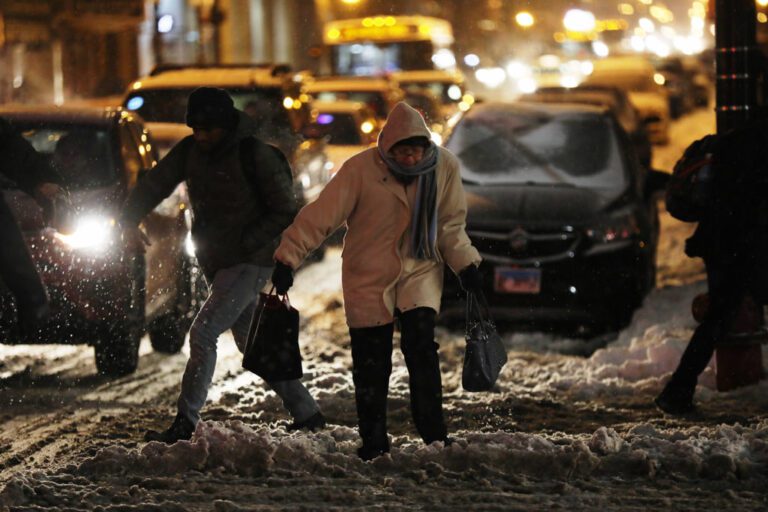Pedestrians battle snow and cold weather on Clinton Street and Jackson Boulevard in Chicago. Photo by Terrence Antonio James/Chicago Tribune/TNS via Getty Images
MILWAUKEE – Hundreds of schools and several major universities closed their campuses Tuesday as temperatures plummeted across the Midwest, with forecasters warning that the frigid weather will worsen and could be life-threatening.
Extreme cold and record temperatures are creeping into a number of states stretching from North Dakota to Missouri and into Ohio after a powerful snowstorm hit the region earlier this week.
Arctic air early Tuesday dropped temperatures in the Dakotas and Minnesota to minus 27 degrees (minus 33 degrees Celsius), with wind chills as low as minus 59 (minus 51 degrees Celsius)
“You're talking about frostbite and hypothermia issues very quickly, like in minutes, maybe even seconds,” said Brian Hurley, a meteorologist at the Weather Prediction Center.
Among the universities to be closed Thursday are the University of South Dakota, Iowa State University and the University of Minnesota. Minneapolis Public Schools officials also canceled classes until Wednesday, when the region is expected to experience freezing temperatures not seen in a quarter century. Hundreds of Michigan schools were closed Tuesday, including in Detroit, while Chicago Public Schools canceled classes Wednesday because of the expected cold.
Closing schools for an extended period of time is not an easy decision, even though most school districts build potential make-up days into their schedules to provide flexibility, said Josh Collins, spokesman for the Minnesota Department of Education.
“A lot of students, they might have two working parents, so staying home might mean they're not being supervised,” Collins said. “For some low-income students, the lunch they receive at school may be the most nutritious meal of the day.”
Sub-zero temperatures hit some states on Tuesday, but Wednesday is expected to be the worst. Wind chills in northern Illinois could drop to minus 55 degrees (minus 48 degrees Celsius), which the National Weather Service called “potentially life-threatening.”
Temperatures in Minnesota could reach minus 30 degrees (minus 34 degrees Celsius) with a wind chill of minus 60 (minus 51 degrees Celsius).
The potentially record low forecast for Milwaukee is minus 28 degrees (minus 33 degrees Celsius), with wind chills as low as minus 50 (minus 45 degrees Celsius). The current record of minus 26 degrees (minus 32 degrees Celsius) was set in 1996.
“That's 40 degrees below normal,” Hurley said.
The unusually cold weather is attributed to a sudden warming far above the North Pole. A burst of warm air from the misplaced Moroccan heat last month caused the normally extremely cold air temperatures over the North Pole to rise rapidly. That split the polar vortex into pieces, which then began to wander, said Judah Cohen, a winter storm expert for Atmospheric Environmental Research.
One of those polar vortex tracks is responsible for sub-zero temperatures across the Midwest this week.
The Chicago Zoological Society announced it is closing Brookfield Zoo on Wednesday and Thursday — marking only the fourth time the zoo has closed in its 85-year history — to ensure the safety of its workers and animals. At O'Hare International Airport in Chicago, the high temperature on Wednesday is expected to be minus 14 degrees (minus 25 degrees Celsius), which would break the record set on January 18, 1994.
Homeless shelters were also preparing for the onslaught of cold weather. Milwaukee Rescue Mission's call volume was “unusually high,” but officials said there should still be enough beds for those who need them.
In Minneapolis, charitable groups that run warming sites and shelters increased hours and capacity “as they do whenever dangerous extreme temperature events occur,” said Hennepin County Emergency Management Director Eric Waage. He said ambulance crews were treating all external response incidents as potentially life-threatening.
Chicago Mayor Rahm Emanuel said city agencies are making sure the homeless are in shelters or offering space on heated buses. He also urged residents to check on their neighbors and take safety precautions.
Cold weather warnings are in effect for a wide area of the central US, from North Dakota to Missouri and extending into Ohio. Temperatures will be up to 20 degrees below average in parts of the Upper Great Lakes region and Upper Mississippi Valley, according to the National Weather Service.
On Monday, snowplow drivers faced problems with snowfall in Minnesota and Wisconsin, where some areas received up to 13 inches of snow.
Sparse snow was also forecast for some southern states.
Nicholson reported from Bismarck, North Dakota. Associated Press reporters Caryn Rousseau in Chicago, Gretchen Ehlke in Milwaukee and David Runk in Detroit, and AP Science writer Seth Borenstein contributed to this report.

